How might we use design thinking as a powerful tool for change? Learn the four ways that can help!

Your free PDF download includes our Guide to Design Thinking as a Powerful Tool for Change. Download your copy today!

ExperienceInnovation is a family of experiential workshops designed to awaken, nurture and improve people’s creative reflexes. With the launch of Aware, the newest member of the ExperienceInnovation family of products, we thought it would be a good time to take a peek behind the scenes of ExperiencePoint’s product development process and the journey from idea to market.
We sat down with Greg Warman, who leads EP’s innovation practice, and Ross Tom, EP’s Head of Marketing, to find out what went into the development of Aware.
Tell us a little bit about Aware.
Greg Warman: Aware is a mobile-enabled, short-seat-time experience that helps people learn and try on the creative reflexes of highly innovative people. It’s part of our broader ExperienceInnovation portfolio, which brings IDEO’s design thinking tools and concepts to the world. At 60-90 minutes, Aware is for rapidly scaling design thinking awareness among a broad set of audiences in an organization.
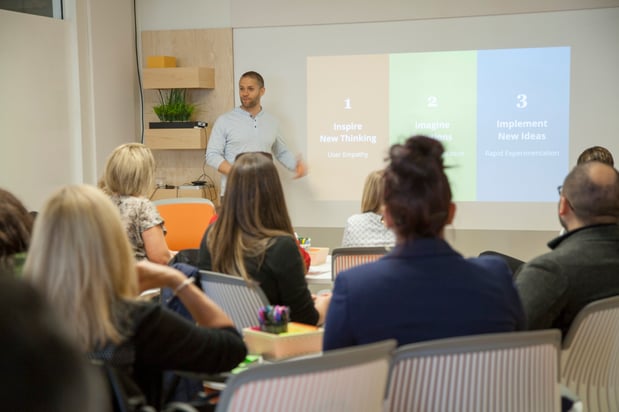
From a high-level perspective, how would you describe ExperiencePoint’s product development strategy?
GW: We have an overarching vision which establishes the “north star” for our product investment decisions. Within that context, there are three phases we follow when we’re developing something new: In the first phase, we’re shaping the dream—establishing the contours of what should be. The second phase involves making the dream concrete and tangible so that we can put it into trusted hands and start rapidly learning how we need to evolve it to achieve outcomes and commercial success. And then finally, we move into our launch phase, where the product is broadly released and continues to improve based on feedback from the field.
So how did the idea for Aware come about?
GW: We went to the sensing function in our organization, which is the sales team. They have conversations all the time with clients about their “wish lists,” and all of these different things had bubbled up in those conversations. We tried to capture those, and then we said to the salespeople, “If you had 100 chips and had to place your bets, where would the chips go?” We gave them the chance to vote, and the big winner was a short-seat-time experience to introduce design thinking—a 60-90 minute, mobile-friendly experience that could be delivered as a keynote or other session and that would be applicable with groups of five to 500 people.
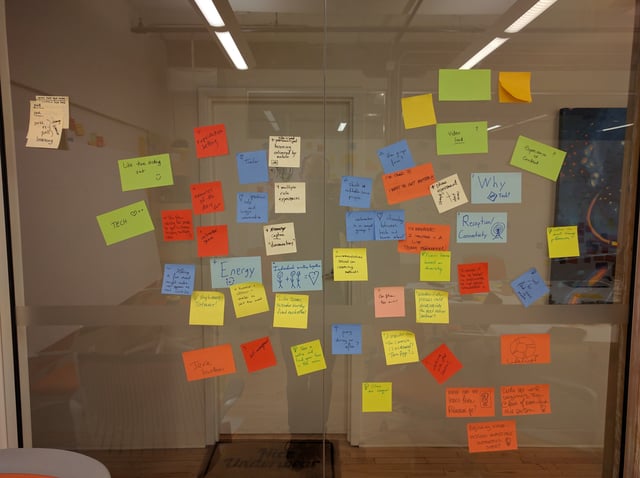
What happened next?
GW: Once we had the contours of the idea, we put it in front of some of our best clients, and we let them imagine how we could make the dream even better. They then gave us their feedback, saying things like, “It would be awesome if I could give this to anyone to run—no facilitator training necessary.” and “Yes, but be sure it’s it compatible with our own innovation model.” That helped provide a little more texture to the dream that we were going to focus on. And so, from this very loose concept, we ended up with the idea to develop “Aware.” We called it that from the outset because it signaled the promised outcome for the audience and positioning within our product portfolio.
What did the development process look like?
GW: It was an iterative process that involved users every step of the way. We started with a week-long design sprint in July of 2016 involving 7-8 EPers from across the organization, including sales, service, delivery, development, creative and EP’s Change practice. We took the design thinking work we were familiar with and then incorporated the Google Ventures model of doing a five-day sprint.
.jpg?width=640&name=235fd0e9-c9a0-4978-b9d5-f673f749cdc0%20(1).jpg)
How was the sprint structured?
GW: We started the first day with deep conversations with clients and partners, and we knew we’d be ending the week with a live beta with a real client. So these were reasonably high stakes, especially because we wanted to be sure we were using our clients’ time well. The week was structured with the goal of inspiring new thinking, converting that thinking into useful ideas and building those ideas so we could run prototyping sessions—one with a client and one with the EP team.
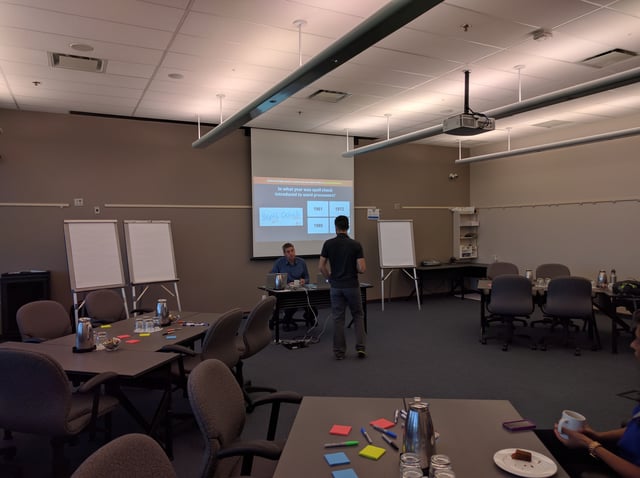
Did everyone work full time on the sprint?
GW: Yes, they did for that five-day-sprint. After the prototyping sessions, we got tons of feedback about what people liked, challenges they had and ideas to improve the overall experience. We prioritized that feedback, and then over the next month, we worked toward the goal of running a beta session for a client with 60 people. At this point, there were two development people working on it full time, and others on the sprint team were only brought in as needed.

So what happened after that beta session with the 60 participants?
GW: Following that session, we organized prototypes that ran every two weeks in our office. We reached out to our network and said, “If you and your colleagues are interested in a 90-minute introduction to design thinking, come by!” We ran those for about two months, and each included an immediate debrief, which resulted in more feedback that we added to the backlog of things to address.
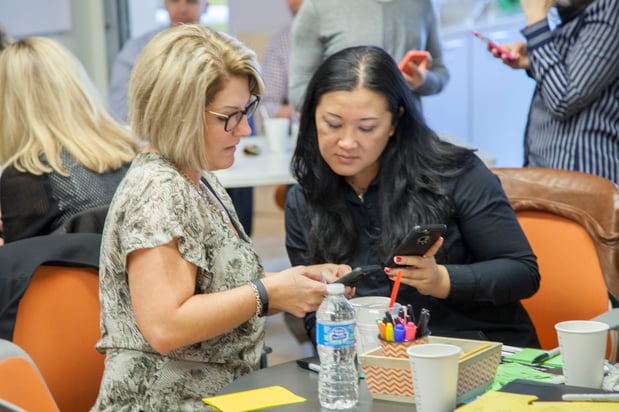
How did you manage all that feedback?
GW: Members of our support, creative, development and design teams got into a weekly meeting rhythm to keep looking at how things were progressing through the backlog and what needed to change.
There was also a second meeting rhythm set around the product launch and involving team members from direct sales, indirect sales, support, marketing, development and delivery. Knowing that the limited release date was set for January 9 and the broad release version was scheduled for the end of March, their goal was to identify all the things that needed to be in place to launch the product—and then hold each other accountable. Their first meeting was held in October, and these originally ran once a month, before moving into a weekly cadence as the release dates got closer.

In essence, the launch was developing right alongside the product’s development.
Ross Tom: That’s right. And as a member of that group—speaking from a marketing perspective—I found it to be a disciplined but flexible approach for commercialization development to coincide with product development. We could test messaging while sales could test pricing.
GW: Delivery was focused on making sure people could use the tool without going through an arduous certification process, so they were able to run some cool experiments with various profiles—for example, a high school teacher who’s never taught design thinking before, or someone who’s certified in our change workshop and has no background in design thinking. What challenges would they have? A lot of what we assumed would be difficult was, but there were also a lot of other challenges we hadn’t anticipated. We learned an incredible amount in that process and iterated on our design accordingly.

It sounds like the delivery component was a big piece of the prototyping experience.
GW: It was, because the content of the tool itself wasn’t new, but the delivery mechanisms were. So the prototyping was more about how to help people who aren’t certified be effective when using it.
How did you select who would get access to the limited release version?
GW: We left it to the discretion of the salespeople, but we were comfortable with letting clients know about it. We did put parameters on what could be sold—for example, no more than 50 participants, no overseas sales due to technical complexities, things like that. And the product continued to evolve during the limited release. There was an immediate debrief with every session.
Did the salespeople have trouble selling a “limited-release” version?
GW: There was no challenge getting them to sell it! Remember, via our “100 chips” exercise, they’d already said this is the thing that people are looking for. Many of them had previously had to say to some long-standing clients, “We don’t really have the perfect fit for you.” Now they could go back and say, “Here it is.” And what’s great is that every promise we made to clients about what the experience would deliver had already been proven via our multiple prototype sessions.
What strikes you most now, looking back on the past nine months?
RT: It’s been humbling to see how it’s gone from an idea to a full-blown experience that’s been brought to market in a relatively short timeframe. It’s been great to witness the iterative evolution of the product. To get really meta about it, we used our own methodologies to build a product that introduced design thinking! Even from a change management standpoint, to mobilize the entire organization around pushing this out to market was cool. Seeing that process work built a great deal of trust in it. There are always elements of ambiguity, which can be both uncomfortable and exhilarating, but it’s comforting to know there’s that scaffolding supporting it.
.jpg?width=619&height=619&name=IMG_6417%20(1).jpg)
GW: In many ways, this approach is a reaction to our previous, highly linear process of “Define, Design, Develop, Deliver.” Not to disparage our previous work and products, but our design decisions were often made based on our whims and assumptions around what should be desireable. The real learning didn’t begin until we put the product in market and then spent years updating and modifying to maximize fit. Now our process is about accelerating the learning through intentional serendipity. By putting something in front of people quickly and getting their feedback, it sparks our creativity and increases the likelihood of fit, and we end up with a better result faster.
Where do you go from here?
GW: We’ll start our broad release of AWARE with our ExperienceInnovation certified facilitators first. We want to learn from them how to best transfer the delivery capability to them. Next, we’ll use those learnings to launch it with ExperienceChange certified facilitators. From there, it will go out to the broader world.
Is there an ExperienceChange version of Aware on the horizon?
GW: There’s no specific plan for that yet, but we know there’s a desire for it. And when we do it, we’ll go through this exact same process again: sprint, iterations, limited release, broad release. The difference is, we’ll already have the technology platform in place, so the time to market will be a lot shorter.
It’s early still, but any interesting client initiatives to share so far?
GW: We already have clients pulling us in interesting directions with ExperienceInnovation Aware. One organization has been conducting an introduction to design thinking and problem solving in their new hire orientation, which involves about 1,200 people annually. As part of the prototyping sessions, we’ve delivered a version of Aware for them that’s more about applying creative energy to real challenges with the objective that the best ideas will be put in front of the company’s leaders. So the company isn’t bringing people together for training; it’s bringing people together to address challenges, and some really cool ideas will come out of it.
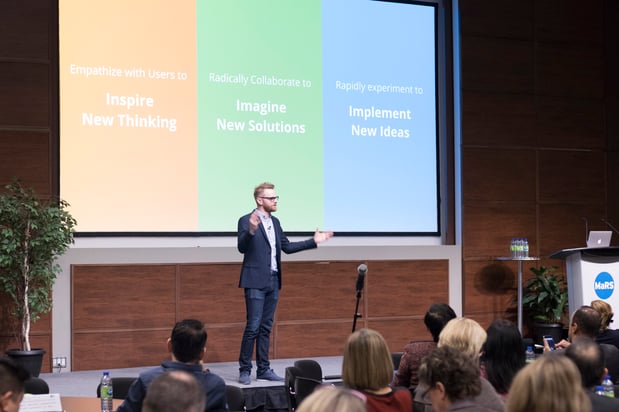
Ultimately, that’s the whole goal for ExperiencePoint: to enable learning and doing in service of solving real problems, doing real work and creating real value.